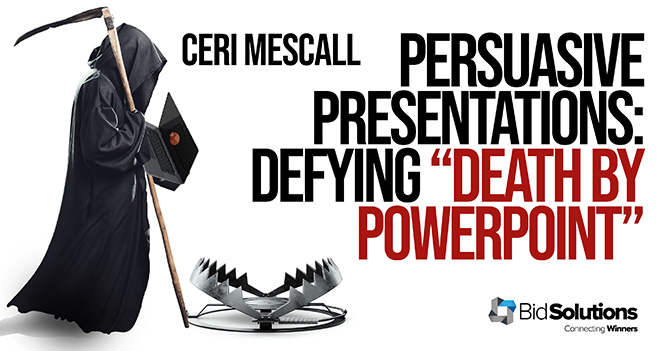
My pro tip is… when preparing for presentations, resist the temptation to develop your slides first – leave them until later.
Why is this pro tip important and why now?
Bids can be won or lost at presentation.
With the rise of generative AI, it’s becoming more challenging to differentiate at proposal stage, especially as some client procurement teams are using AI to evaluate proposals. Presentations are still a golden opportunity to connect with client evaluators on a human-to-human basis to help them choose your organisation.
However, presentation prep is often rushed and under-resourced. Poor presentations re-hash the proposal or are a “Frankenstein’s monster” of slides from past presentations.
What should you do before developing your slides?
- Establish key parameters: Ask clarification questions such as “What’s the agenda?”, “Will the presentation be in-person or virtual?”, “Who are the client attendees?”, “What are the evaluation criteria/scoring rubric for the presentation?”, “How much time do we have?”
- Assemble your team: Select team members based on the value they will provide to the client at the presentation rather than just seniority level or availability. Agree speakers for each agenda item. Provide team members with the RFP, your proposal, and any other relevant information.
- Draft your messaging framework: People buy based on emotion and logic. Align the client’s agenda items with your win themes to construct a compelling story. Establish how you want the client evaluators to feel at each stage of the presentation (e.g., curiosity, trust). Decide what you want them to remember (e.g., proof points and responses to potential objections). Determine what action you want them to take (e.g., contract award recommendation).
- Prepare individually: Draft speaker notes (not a full script) and practice. Consider using Microsoft’s Speaker Coach to evaluate your pacing, pitch and use of filler words, informal speech, euphemisms, and culturally sensitive terms. If the client presentation will be in-person, rehearse in front of a full-length mirror so you can see your stance, posture, and movement.
- Rehearse as a team: Run through your content. Give and receive feedback. Work on tricky areas such as transitions/handovers between presenters and how to answer tough questions from client evaluators.
Then develop your slides, but:
- Be brief: A good benchmark is one slide for every three minutes of presentation.
- Be visual: The human brain processes images much faster than text. It’s difficult for a client evaluator to read text and listen to you present. Opt for diagrams and charts rather than bullet points. If you’re feeling uninspired, use a text-to-image AI tool for ideas for graphics.
- Be inclusive: Consider aspects like font sizes, colours, headings, and alt text
Why does this pro tip work?
- It increases persuasiveness
- It drives accountability from each speaker
- It minimises re-work
This article was written by Ceri Mescall.
Ceri Mescall is a proposal consultant based in Victoria, British Columbia, Canada. Clients trust her to help them win. Ceri’s a thought leader – a presenter/panellist, podcast guest, article author/contributor, and awards judge. She holds all four signature Association of Proposal Management Professionals (APMP) certifications plus the Executive Summaries and Bid & Proposal Writing micro-certifications. Ceri was an APMP 40 Under 40 award winner (class of 2019) and is an APMP Fellow (2020).

